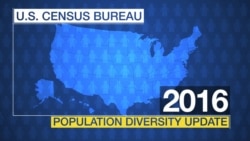All races and ethnic groups grew in the U.S. over the last year, but the Asian and Hispanic populations continued to be the fastest-growing, according to the annual count released Thursday by the Census Bureau.
The census reports that across all races and ethnic groups, the non-Hispanic white population grew the slowest.
"The non-Hispanic white alone group grew less than one-hundredth of one percent and only gained about 5,000 people,” Lauren Medina, a census demographer, said in a news release.
The census’ National, State and County Population Estimates by Age, Sex, Race and Hispanic Origin report says that as of July 1, 2016 the U.S. Hispanic population was 57.5 million, an increase of 2 percent since the last study a year earlier.
Meanwhile, the Asian population grew to 21.4 million at the fastest growth rate of all ethnic groups at 3 percent.
The report comes from the census’ State Data Center Program, which works with data coming from 50 states, the District of Columbia, Puerto Rico and the island areas. This information comes from networks of state agencies, universities, libraries, and regional and local government.
Birth rates
The study estimates that all groups had more births than deaths in the last year, except non-Hispanic white people, who have experienced a decrease in births by 163,300 nationally.
Monica Gomez Isaac, executive director of the Institute for Immigration Research at George Mason University, said the increase in the Hispanic and Asian populations can be attributed to higher birth rates - and “that's projected to grow.”
As a result, she said, the U.S. population is becoming more ethnically diverse.
However, she said that 50 years ago, immigrant populations grew for different reasons.
“The abolishment of national origin entry quotas from the 1965 Immigration and Nationality Act made it possible for a greater diversity of immigrants to be admitted into the country” – especially from Latin American and Asia.
Geographically, the new census data shows the majority of Asians and Hispanics reside in states in the U.S. West.
California has the largest Hispanic and Asian population with 15.3 million and 6.6 million, respectively.
Texas had the highest numeric increase in Hispanic population at 233,100 people while 57 percent of the Hawaiian population is of Asian origin.
2020 census
The Census Bureau makes a count of everybody living in the U.S. and its territories every 10 years. The count is mandated by the Constitution and will next take place in 2020.
The Bureau mails surveys to every U.S. household with questions that include number of residents, their ages and ethnicity.
Census surveys also allow people to select more than one race when responding to questionnaires. As a result, some residents may be one race or a combination of races. The question of Hispanic origin can reflect people of Hispanic, Spanish or Latino origin.
The 2020 count already is enmeshed in some controversy because of a historically low budget request by the White House for fiscal year 2018. The Census Project watchdog group says that just when the bureau should be ramping up for the census, it is having to cut back on field tests.
“This means the chances of a dramatic undercount of the population in the 2020 census increase,” the group says on its website, adding that the risk is particularly high in “communities of color and rural residents.”










